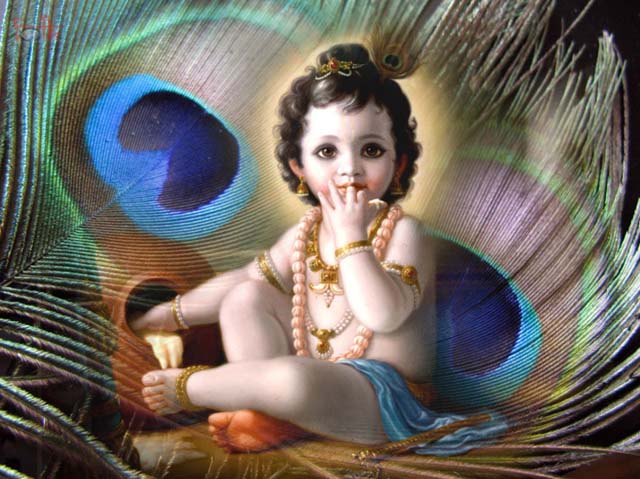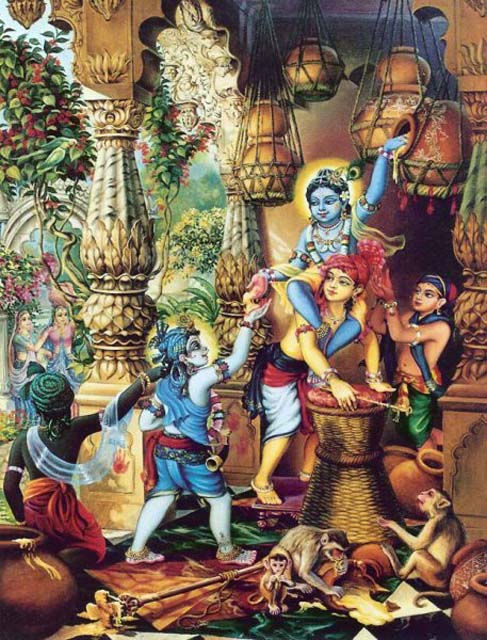13,752 people reached on Lassi with Lavina FB page -377 engagements – 25 Likes
538 views on LinkedIn – 8 Likes

Janmashtami Story – The Birth of Krishna
[dropcap]T[/dropcap]o know Sri Krishna is to adore him. He is the blue-skinned God, the eighth incarnation of Vishnu, Preserver of the World. He is the Cosmic Cowherd, the mischievous deity that Hindus love the most for his pranks, for his butter-thievery, for his melodious flute, for his romantic interludes with Gopis, the milkmaids. He fought demons, danced on the mighty serpent’s head and lifted Govardhana Hill with his little finger, using it as an umbrella to protect the people from torrential rains.
Yet one anecdote encompasses it all: as a naughty child hankering after butter, he would stand on the shoulders of other children to reach the pots of butter that hung from the ceiling. His mother, sure the incriminating proof was in his mouth, ordered him to open his mouth. She was mesmerized to see entire universes in the child’s mouth, and knew then that all the incidents were merely part of the Lord’s Leela or celestial play.
This year Janmashtami – the birth of Sri Krishna – falls on September 6. It is little surprise then that devotees gather in the hundreds, in the thousands in temples across India, and the world. It is a very special day and they wait in anticipation, surrounding the symbolic baby crib, singing devotional songs.
The story behind the birth of Krishna is intriguing: the wicked King Kansa had been told that he would meet his death at the hands of his yet unborn nephew. To thwart that, he had his only sister Devaki and her husband Vashdev imprisoned, and murdered each of their seven sons as they were born.

Just as the eighth child – Sri Krishna – was born – the prison locks magically opened and Vashdev managed to escape with the baby Krishna in a wicker basket on his head. The river was raging but touching the divine baby’s feet, it receded. Krishna was brought up by a simple cowherd Nand and his wife Yashoda, and the evil Kansa did meet his death at his hands, as it was foretold.
Krishna and the Bhagavad Gita
[dropcap]S[/dropcap]ri Krishna is the vanquisher of all evil and the guide for right living. In the mighty Mahabharata war in which the Pandavas battled their kinsmen, the Kauravas, he drove the Pandava warrior Arjuna’s chariot and instructed him to perform his duty, to be on the side of dharma or righteousness.
When Arjuna hesitated to fight against his own brethren, Krishna enlightened him with wisdom that encompasses all aspects of living. These words are immortalized in the 700 slokas of the Bhagavad Gita or the Song of the Lord, which has sustained people across the world.
The teachings of Bhagavad Gita are applicable to the entire human race irrespective of race or faith. It has been said that when you are faced with difficulties, open any page in the Gita, you will find the answer.

Krishna and Cosmic Love
[dropcap]W[/dropcap]hy do Hindus love Krishna so much? He is the all-pervading, omnipresent One without whom even a leaf cannot stir, but he assumes a very accessible human form, becoming babe, naughty child, son, friend and lover. There is an instant bonding and connection between this deity and his devotees because Krishna is all about love.
In fact, the Bhakti or devotional movement in many parts of India revolves around Krishna, for his love for his beloved Radha is about cosmic love, about the union of soul and the Supreme Being.
Krishna is very much a part of a Hindu’s life: Many children are named after him – the deity has hundreds of names so there’s plenty to choose from! Interestingly, Krishna is a name for both male and female children and the parents certainly hope they will take on his shining attributes. Other names include Gopala, Govinda and Sreenath. Everything associated with Krishna is auspicious – there’s even a Krishna Savings Bank in Delhi and a Lord Krishna Bank in Kerala!
His devotees are also found in the Krishna Consciousness Movement that was started in the U.S. by A.C. Bhaktivedanta in the 60’s and which now has centers all over the world. You may have seen the Hare Krishna devotees of ISKCON, the Society for Krishna Consciousness, dancing on the streets and at airports.
Walk into a Hare Krishna temple and you see the same blissful abandon before the images of Krishna, and vegetarian feasts are served, based on the many delicacies that Krishna loved – butter, ghee and milk.
Since the 60’s, many Indian immigrants have settled in America and there are now scores of temples across the nation where Krishna Janmashtami is celebrated with pomp and pageantry, with dance performances and plays of his life.
Many devotees also fast on this day, eating only after midnight, says Pundit Mahesh Shastri, a Hindu priest. He explains that the icon of Sree Krishna is bathed in milk, yogurt, ghee, honey, sugar and water. A traditional prasad or benediction is given to all the devotees – the Panchajiri, made of five ingredients, in North Indian temples while South Indian temples favor puffed rice, a great favorite of Krishna.

Janmashtami Celebrations
[dropcap]I[/dropcap]n India, the day after Janmashtami is one of revelry, keeping with Krishna’s fun-loving spirit. Clay pots of curds and butter are suspended from poles in the streets in towns like Mathura and Vrindaban, where Krishna lived, and also in cosmopolitan cities like Mumbai.
Bands of boisterous youth form human towers to get to the pots, mimicking Krishna’s exploits. To shouts of ‘Govinda Ala Re!’ (Govinda is coming!) colored water is thrown on bystanders and participants – and yes, the pots contain money for those daring enough to reach them!
[dropcap]I[/dropcap]ndeed, what’s a birthday without fun and games? Yet Janmashtami has a much deeper meaning – it’s a reminder to do one’s duty in life, no matter how difficult, and to keep on the path of dharma, to surrender one’s life to Krishna because all else is maya or illusion.
As Sree Krishna explains in the Bhagavad Gita: “Before creation I alone existed. There was nothing, neither existence nor non-existence. I am that which remains after dissolution.”
© Lavina Melwani
https://www.facebook.com/LassiwithLavina
(This article first appeared in Beliefnet.com)
(Photos courtesy: Iskcon Desire Tree)
Related Articles:

9 Comments
Via Google
7 Google +
Right Indian Politics +1’d
Lavanya Naidu +1’d
Dinesh Arun +1’d
Ranjit Shilsarma +1’d
amar singh +1’d
Kl notty ponne 21 notty ponne 21 +1’d
Sunil Sawant +1
Via Google +
Tashu Sharma and Anuj shah
+1’d: He is the blue-skinned God, the eighth incarnation of Vishnu,
Jayanthi, thanks so much for your comments – enjoyed writing it!
Hi Lavina – Happy Janmashtami to you and your family. Your write-up on Lord Krishna, his exploits as a child, and the important lessons that we need to learn from the Bhagavad Gita are all well enumerated. Overall, an enjoyable article!!
Warm regards
Jayanthi
Hi Ankita – so glad you enjoyed the story. I enjoyed writing it!!
Via Lassi with Lavina on Facebook
60 people liked it on Facebook’s Lassi with Lavina page
It was seen by 5172
5 shares
https://www.facebook.com/LassiwithLavina
Via Lassi with Lavina page on Facebook
Wish you all a very Happy Janmashtmi.
Padi Surtani
Via Lassi with Lavina page on Facebook.
Akash Parer Tara
happy janmastami…
Haathi ghoda paalki, Jai Kanhiya Lalki!!
Loved reading it!!
Jai Shree Krishna 🙂
Ankita Singhal